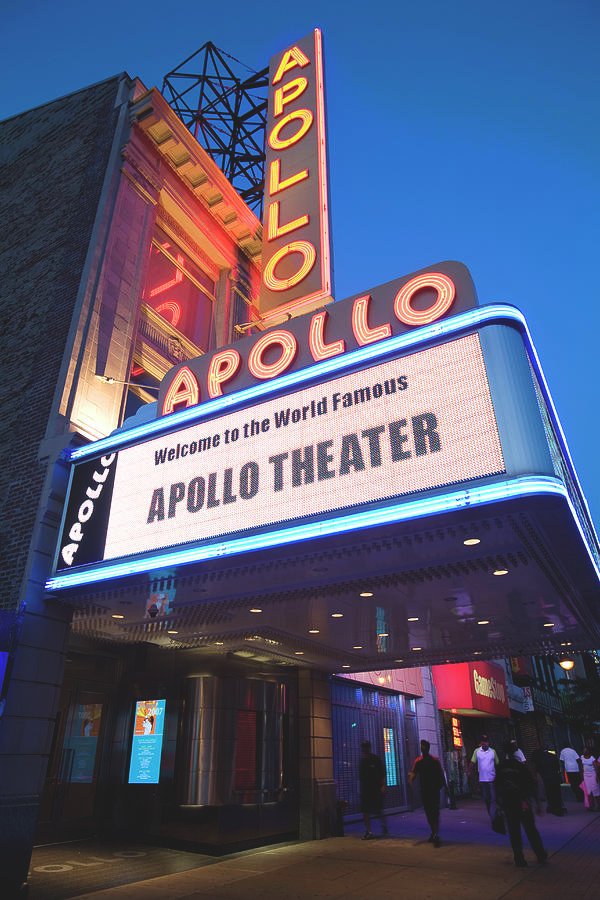
Si hay un lugar que representa el alma de la música negra en Estados Unidos, ese es el Teatro Apollo en Harlem. Ubicado en la calle 125 de Nueva York, el Apollo no ha sido solo un escenario, sino un auténtico campo de batalla, una plataforma de lanzamiento y un santuario donde nacieron leyendas. Construido originalmente en 1913 como un teatro de burlesque, su verdadera historia comenzó en 1934, cuando fue reimaginado como un espacio para artistas negros. Ese mismo año, el teatro dio inicio a su legendaria “Noche de Aficionados”, un concurso de talentos que sirvió como trampolín para artistas como Ella Fitzgerald. Para finales de los años 30, el Apollo ya era el epicentro de la explosión cultural de Harlem, recibiendo a los nombres más grandes del jazz, el blues y el swing.
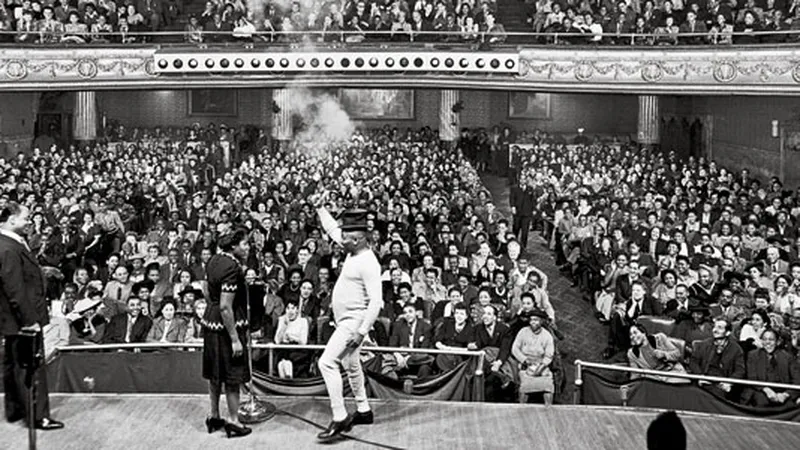
A pesar de los tiempos turbulentos de la Segunda Guerra Mundial, World War IIlos años 40 fueron una edad dorada para el Apollo. Con Harlem ardiendo de creatividad, el teatro se convirtió en el epicentro del swing y del emergente bebop Duke Ellington, Count Basie, and Cab Calloway transformaron el escenario del Apollo en su hogar, llevando la fuerza del jazz de big band a un público sediento de ritmo. Pero el gran terremoto musical llegó en la mitad de la década, cuando un joven saxofonista llamado Charlie Parkerjunto al trompetista Dizzy Gillespiedesafiaron todas las reglas con el bebop—un sonido más rápido, complejo y revolucionario. Bebop no era solo música, era un manifiesto, una ruptura con lo establecido, y el Apollo fue el escenario perfecto para esa revolución. Al mismo tiempo, Billie Holiday dejó una huella imborrable con interpretaciones estremecedoras de Strange Fruitun himno desgarrador que fusionó el arte con la protesta política.
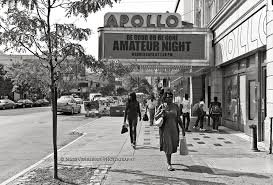

En la década de 1950, el Apollo pasó de ser un templo del jazz a a cuna del rhythm and bluesLa música negra estaba evolucionando, y el Apollo estaba en el corazón del cambio. Ray Charles, Ruth Brown, and Fats Domino llevaron el sonido del góspel, el blues y el swing a un nuevo nivel, sentando las bases del rock ‘n’ roll. James Brown pisó por primera vez el escenario del Apollo en los 50, preparando el camino para sus legendarias actuaciones en las décadas siguientes. También fue la era del doo-wop, con grupos como The Drifters y The Coasters perfeccionando sus armonías bajo los reflectores del Apollo. Pero nadie encarnó la explosión del R&B en el Apollo como Little Richardcuya energía desbordante y su manera frenética de tocar el piano transformaban cada presentación en una experiencia religiosa. Mientras el rock ‘n’ roll comenzaba a conquistar Estados Unidos, el Apollo se mantenía como un recordatorio de dónde comenzó todo: conartistas negros, público negro y puro soul sin filtros.
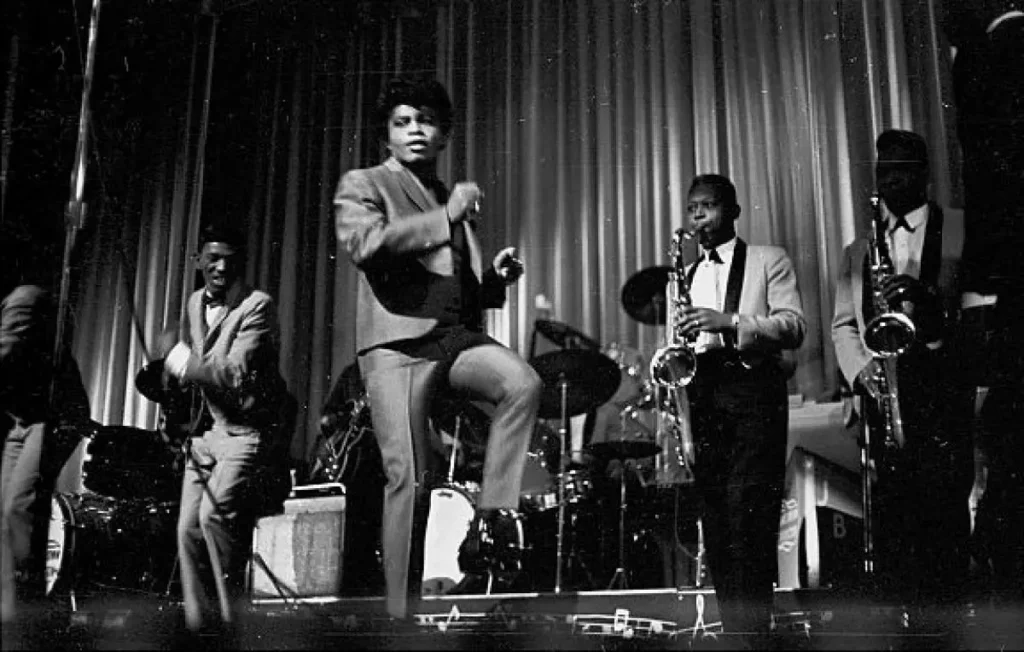

Para los años 60, el soul había tomado el control del Apollo, y nadie lo representó mejor que James Brown. Su álbum Live at the Apollo (1962) se convirtió en uno de los discos en vivo más icónicos de la historia, capturando la energía bruta de Brown y el furor de la audiencia del Apollo. Más que un concierto, los shows de Brown en el Apollo eran maratones de sudor, baile, gritos y una maestría musical inigualable. Mientras tanto, Aretha Franklin, la Reina del Soul, convirtió al Apollo en una iglesia del poder vocal, con interpretaciones inolvidables de Respect and Chain of Fools También fue la época en la que el sonido pulido de Motown conquistó Harlem, con The Temptations, The Supremes y Marvin Gaye llevando el estilo de Detroit al legendario teatro. Mientras el movimiento por los derechos civiles sacudía el país, el Apollo era un refugio donde el talento y la excelencia negra brillaban por encima de cualquier adversidad.
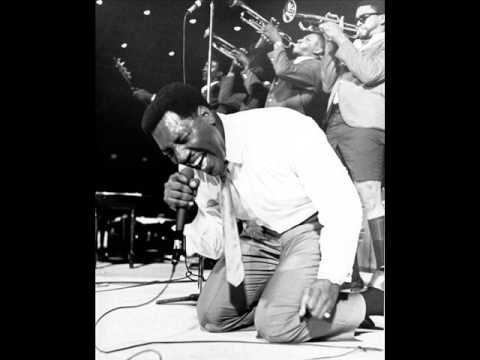
Los 70 fueron la era del funk, y el Apollo se convirtió en su templo. James Brown seguía dominando, pero ahora compartía escenario con Parliament-Funkadelic, The Isley Brothers y Earth, Wind & Fire, quienes convirtieron el teatro en una galaxia funkadelica. El disco también tuvo su momento, con artistas como Donna Summer y Chic haciendo vibrar el lugar. Sin embargo, a pesar de su impacto cultural, el Apollo comenzó a enfrentar dificultades financieras. En 1976, las puertas del teatro cerraron, incapaz de sostenerse en medio de los cambios de la industria musical y las crisis económicas de Harlem. Durante dos años, el silencio reinó en el Apollo, una pausa desgarradora en una historia de décadas de música.
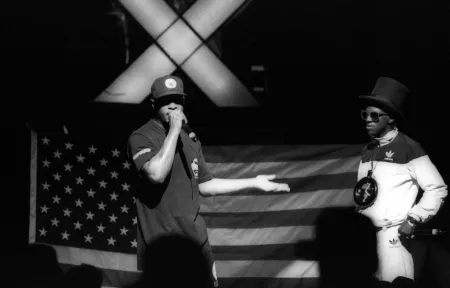
En 1978, el Apollo resurgió gracias a Percy Sutton, un visionario que vio su enorme potencial. Durante los 80, el teatro fue renovado y encontró nuevas formas de mantenerse relevante. En 1987, nació el legendario programa de televisión “Showtime at the Apollo”, una nueva versión de la “Noche de Aficionados” que presentó al mundo a talentos emergentes. Steve Harvey se convirtió en el presentador más icónico del show. En los 90 y 2000, el Apollo abrazó al hip-hop, con artistas como The Notorious B.I.G., Lauryn Hill y Jay-Z dominando el escenario, demostrando que el Apollo no era solo una reliquia del pasado, sino una fuerza activa en la música moderna. Hoy, el teatro sigue en pie, funcionando como un espacio vibrante, donde conviven el neo-soul, el rap, el jazz y todas las expresiones de la música negra.
El Teatro Apollo no es solo un lugar, es un símbolo, una institución y un refugio para la cultura negra. Sin el Apollo, quizás no habríamos tenido a Ella Fitzgerald, James Brown o Lauryn Hill. Sin el Apollo, muchos artistas jamás habrían encontrado una plataforma para transformar sus sueños en historia. Pero más que eso, el Apollo representa el poder del arte negro, la prueba de que la música nacida de la lucha, la resiliencia y la alegría puede cambiar el mundo. Mientras el Apollo siga en pie, el alma de la música negra seguirá viva. Este teatro no es solo un edificio, es un legado, una promesa de que el pasado, presente y futuro de la música siempre tendrán un hogar en Harlem. Y por eso, debemos protegerlo, celebrarlo y asegurarnos de que sus puertas nunca vuelvan a cerrarse.

Aquí téis un desglose de los de 10 músicos principales que han actuado en el Teatro Apollo, década tras década, desde la década de 1930 hasta el presente.
1930s: The Jazz & Swing Era
1. Ella Fitzgerald (jazz singer, debuted at Amateur Night in 1934)
2. Count Basie (pianist, bandleader)
3. Duke Ellington (pianist, bandleader)
4. Chick Webb (drummer, led house band)
5. Cab Calloway (singer, bandleader)
6. Fats Waller (pianist, singer)
7. Louis Armstrong (trumpeter, jazz legend)
8. Bill “Bojangles” Robinson (tap dancer, entertainer)
9. Bessie Smith (blues singer)
10. Lionel Hampton (vibraphonist, jazz pioneer)
1940s: The Bebop and Blues Explosion
1. Charlie Parker (saxophonist, bebop innovator)
2. Dizzy Gillespie (trumpeter, bebop co-founder)
3. Billie Holiday (jazz and blues singer)
4. Thelonious Monk (pianist, jazz pioneer)
5. Sarah Vaughan (jazz singer)
6. Nat King Cole (pianist, singer)
7. Lionel Hampton (vibraphonist, bandleader)
8. T-Bone Walker (blues guitarist)
9. Big Joe Turner (blues shouter, rock ’n’ roll precursor)
10. Louis Jordan (jump blues pioneer)
1950s: R&B and Rock ‘n’ Roll Take Over
1. Ray Charles (pianist, singer, early soul pioneer)
2. Fats Domino (pianist, rock ’n’ roll star)
3. Little Richard (pianist, rock ’n’ roll icon)
4. Chuck Berry (guitarist, rock ’n’ roll pioneer)
5. James Brown (the Apollo legend, debuted in 1956)
6. Ruth Brown (R&B singer, “Queen of R&B”)
7. Lloyd Price (R&B singer, “Lawdy Miss Clawdy”)
8. Big Mama Thornton (blues singer, original “Hound Dog”)
9. Bo Diddley (guitarist, rock ’n’ roll innovator)
10. Jackie Wilson (soul singer, early influence on Motown
1960s: The Soul Explosion
1. James Brown (Live at the Apollo, 1962)
2. Aretha Franklin (Queen of Soul)
3. Marvin Gaye (soul singer, Motown legend)
4. Stevie Wonder (child prodigy, soul genius)
5. Otis Redding (soul singer, Stax icon)
6. Sam Cooke (gospel to soul pioneer)
7. Wilson Pickett (R&B powerhouse)
8. Curtis Mayfield (singer-songwriter, The Impressions)
9. Isaac Hayes (composer, singer, Stax Records)
10. Al Green (soul and gospel legend)
1970s: Funk, Disco, and a Shifting Scene
1. James Brown (now a funk icon)
2. George Clinton (Parliament-Funkadelic mastermind)
3. Chaka Khan (funk and R&B powerhouse)
4. Patti LaBelle (disco, R&B legend)
5. Michael Jackson (as part of The Jacksons)
6. Maurice White (Earth, Wind & Fire leader)
7. Bootsy Collins (funk bassist)
8. Sly Stone (Sly & The Family Stone)
9. Barry White (deep-voiced disco-soul singer)
10. Nile Rodgers (guitarist, Chic mastermind)
1980s: The Era of R&B, Hip-Hop, and Musical Reinvention
1. James Brown (Though a ‘60s icon, he continued to perform at the Apollo in the ‘80s)
2. Stevie Wonder (Brought his genius musicianship and vocal mastery to the Apollo)
3. Aretha Franklin (The Queen of Soul remained a staple of the Apollo stage)
4. Miles Davis (The jazz icon performed at the Apollo, showing his evolution)
5. Herbie Hancock (Blended jazz with funk and electronic sounds at the Apollo)
6. Luther Vandross (His smooth R&B performances were legendary)
7. Rick James (The Apollo witnessed his wild and funky energy live)
8. Whitney Houston (Early career performances at the Apollo)
9. Big Daddy Kane (One of hip-hop’s greatest lyricists showcased his skills here)
10. Prince (One of his most electrifying live performances happened here)
1990s: The Golden Age of Hip-Hop & the Rise of Neo-Soul
Main Musicians:
1. Nas (lyrical genius, early Apollo performances)
2. The Notorious B.I.G. (performed before superstardom)
3. Jay-Z (showcased at Apollo in his rise to fame)
4. Mary J. Blige (the Queen of Hip-Hop Soul)
5. Method Man & Redman (Wu-Tang and Def Squad legends)
6. Missy Elliott (hip-hop and R&B visionary)
7. Toni Braxton (soulful diva)
8. Maxwell (helped define the neo-soul movement)
9. Dr. Dre & Snoop Dogg (West Coast legends who graced the stage)
10. Lauryn Hill (as part of The Fugees and solo)
⸻
2000s: R&B Dominance & Hip-Hop’s Global Takeover
1. Kanye West (performed during early career)
2. Beyoncé (returned to the Apollo as a global superstar)
3. Alicia Keys (piano-driven R&B brilliance)
4. John Legend (soulful singer-songwriter)
5. Common (hip-hop storyteller)
6. Jill Scott (neo-soul queen)
7. Erykah Badu (continued to influence the scene)
8. Mos Def (Yasiin Bey) (lyrical hip-hop heavyweight)
9. Ne-Yo (R&B hitmaker)
10. OutKast (Andre 3000 and Big Boi, unique innovators)
2010s: Hip-Hop’s New Wave & The Resurgence of Soul
1. Kendrick Lamar (arguably the greatest rapper of his generation)
2. J. Cole (conscious lyricist and performer)
3. Drake (from rapper to global pop star)
4. Frank Ocean (R&B’s enigmatic genius)
5. Anderson .Paak (modern funk and soul revivalist)
6. The Weeknd (dark R&B meets pop superstardom)
7. Solange (alternative R&B visionary)
8. Childish Gambino (Donald Glover) (genre-bending creative force)
9. Rihanna (R&B/pop queen)
10. Lizzo (funk, rap, and soul fusion)
2020s-Present: A New Era of R&B, Afrobeats, and Genre Fusion
Main Musicians:
1. Burna Boy (Afrobeats king bringing African sounds to the Apollo)
2. Tems (Nigerian R&B powerhouse)
3. Tyler, The Creator (genre-defying rapper and producer)
4. Doja Cat (hip-hop/pop/R&B fusion)
5. Billie Eilish (pushing alternative pop boundaries)
6. Giveon (deep-voiced R&B breakout star)
7. SZA (leading the new wave of alternative R&B)
8. Latto (rising rap star)
9. Megan Thee Stallion (rap queen with undeniable energy)
10. Silk Sonic (Bruno Mars & Anderson .Paak) (modern funk revivalists)

